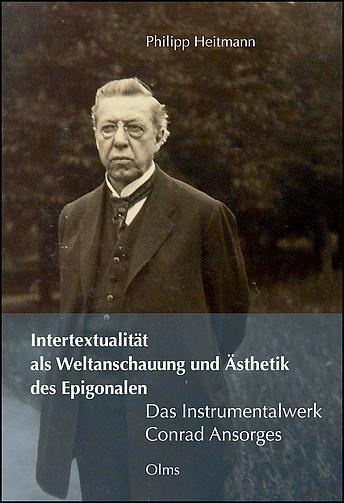Heitmann
Intertextualität als Weltanschauung und Ästhetik des Epigonalen
ISBN 978-3-487-15255-4
englischHardly any other body of work could be expected to reveal such a wealth of hidden compositional, intellectual, philosophical and ideological depths as that of the turn-of-the-century pianist, pupil of Liszt, and once-famous Beet-hoven performer and ‘mystic’ Conrad Ansorge (1862-1930). Each individual work opens up intertextual ‘chasms’ which led to digressions into the history of ideas. The central theme, Ansorge’s musically and intertextually generated philosophy of life, is the eternal principle of the ‘cosmogonoic Eros’ which can be traced in three ways: through the Eros philosophy of Stefan George and the ‘Cosmic Circle’, through (Indian) theosophy, and finally through Orphism, the ancient Greek underground religion. Musically Ansorge’s references span the ‘mystic triangle’ of Beethoven-Brahms-Liszt. These references, often concealed in deep structures, form a network which binds the whole work with ist own dynamics – behind it all is a plea for a sovereign and elite aesthetic of mimesis. Ansorge’s instructive and precise ‘Communications’ anticipate insights which would only be verified by musicology in the late 20th century, and shed new light on some works of the three ‘masters’.
Damit ist Heitmanns Dissertation immanent auch ein deutlicher Appell, die Vielfalt der Forschung zu erhalten und sowohl klassische Projekte zu fördern als auch solche, die Fächergrenzen und Denkbarrieren überschreiten – wie die vorliegende, Seite für Seite lesenswerte und sicherlich zu Diskussionen anregende Arbeit. (Kadja Grönke, Die Tonkunst, 3. Jg., 10/2016) Kaum ein Œuvre dürfte mit einem solchem Reichtum an verborgenen kompositions- und geistesgeschichtlichen sowie philosophisch-weltanschaulichen Tiefen aufwarten können wie das Werk des Jahrhundertwende-Pianisten, Lisztschülers, seinerzeit berühmten Beethovenspielers und ‚Mystikers‘ Conrad Ansorge (1862-1930). Die zweifellos auf Enträtselung angelegte Konstruktion zielt auf ein neues ästhetisches Kompositions- und Werkkonzept. Jedes Einzelwerk eröffnet intertextuelle ‚Abgründe‘, die in geistesgeschichtliche Exkurse münden. Roter Faden, Ansorges musikalisch-intertextuell generierte Weltanschauung, ist das Ewigkeitsprinzip des „kosmogonischen Eros“, das auf drei Wegen verfolgt wird: über Eros-Philosophie aus dem Stefan-George- und „Kosmiker“-Kreis, über (indische) Theosophie und schließlich Orphik, eine griechisch-antike Untergrundreligion, hier Metapher für eine literarisch-geistesgeschichtliche Kunstreligion ‚aus dem Geiste der Musik‘. Musikalisch spannen Ansorges Bezüge das ‚mystische Dreieck‘ Beethoven-Brahms-Liszt auf. Die oft in Tiefenstrukturen gelegenen Bezüge bilden eigendynamisch ein werkübergreifendes Netz, das sich summarisch als ‚Architektur‘ und ‚Weltgebäude‘ begreifen lässt. Hinter allem steckt ein Plädoyer für eine souveräne und elitäre Ästhetik des Epigonalen. Ansorges lehrhafte und bestimmte ‚Mitteilungen‘ gewähren tiefe Einblicke in sein Denken, nehmen Erkenntnisse vorweg, die die Musikwissenschaft erst im späteren 20. Jh. verifizieren wird, und rücken manches Werk der drei ‚Meister‘ in neues Licht.


